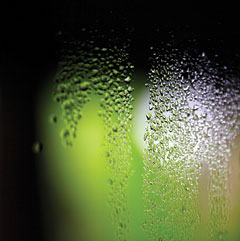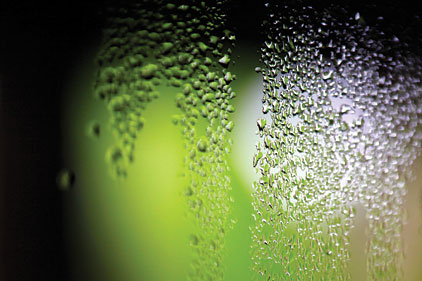When it comes to IAQ, humidity plays an influential role in the health, safety, and comfort of occupants in buildings and homes. Settling this uncertainty falls solely on the shoulders of HVACR contractors, who admittedly devote a lot of their time to solving and controlling such climate conundrums.
Finding the Comfort Zone
 “There’s a certain humidity range we humans like to live within,” said Rick Tullis, president, Capstone Mechanical, LP, Waco, Texas. “If we start getting outside those parameters, bad things start to happen with the illnesses that come upon us, impacting everything from our skin and sinuses, making us more susceptible to different viruses and bacteria. We like a certain range, ideally, and other organisms do, too.
“There’s a certain humidity range we humans like to live within,” said Rick Tullis, president, Capstone Mechanical, LP, Waco, Texas. “If we start getting outside those parameters, bad things start to happen with the illnesses that come upon us, impacting everything from our skin and sinuses, making us more susceptible to different viruses and bacteria. We like a certain range, ideally, and other organisms do, too.
“Some of the molds and other creatures like it when it’s really moist, and they start to do bad things to our homes, our structures, our buildings, and beyond,” he said. “With all that being said, we have to work to keep things within the right range.”
When humidity is kept to a certain level — ASHRAE recommends between 30-60 percent relative humidity for homes — air moisture-related issues are kept at bay.
“If you don’t have moisture, you don’t have mold, period,” said Larry Pearson, owner, Panoramic Building Performance Solutions, Bradenton, Fla. “When people say they have a mold problem, I tell them they have a moisture problem. A mold problem is always a moisture problem. End of story. You’ve got to control humidity if you want to control mold. If you create an environment inside of a building with acceptable humidity levels, you won’t have a mold problem unless there’s a plumbing leak or something like that.”
The moisture that is humidity presents some challenges in all applications. Tullis said his company recently had a job at a library in a special room for old, archived materials. He said, because of the condition of the materials, there was a very thin temperature and humidity range to be adhered to. He said this required some precise equipment and controls.
On the other hand, Tullis has found himself dealing with a broad range of issues involving humidity throughout his career. “We’ve had some experiences in a diaper plant,” Tullis said. “What goes into diapers? It’s little pellets that love to absorb moisture. This diaper plant had been designed by people from up north who weren’t used to the temperature and humidity challenges we have here in Texas. As a result, they had a building that had a very high relative humidity, which was causing the pellets to absorb moisture and expand in the manufacturing delivery pipes. Those pipes clogged because the pellets were absorbing the moisture and expanding. We encounter all kinds of fun scenarios like that.”
Lew Harriman, director of research, Mason-Grant Consulting, Portsmouth, N.H., said a firm grasp on humidity will provide comfort and save energy.
“Those are the two big reasons,” he said. “Lurking behind that are things like mold prevention. You really have to screw up in a major way to have mold problems in a building. More than one thing has to go wrong to have a mold problem. … If you don’t control humidity, people will use the thermostat to try to achieve comfort by forcing down the temperature set point, then lots of bad things happen. Energy gets all crazy because you’re using energy to do a job that’s difficult to do, and it also creates cold surfaces, which is when you get into the risk of mold. So if you don’t control humidity independently of the temperature set point, you will be using the temperature set point to control it. That’s where the energy and comfort problems come in, and that’s true in both light commercial and residential settings.”
Tullis agreed, stating that if the humidity varies wildly, comfort levels could be all over the board, regardless of the temperature.
On spring and fall days in Texas, where it could be 75˚F in the morning — which isn’t quite hot enough to turn on the air conditioning in Texas but the humidity is raging around 90 percent — it creates a problem for commercial buildings like schools that have to bring in a certain amount of fresh air to comply with ventilation standards.
“It definitely gets tougher when you get into many of the commercial settings because you’re dealing with so much more outside air,” Tullis said. “If you’re getting involved in auditoriums or office buildings, you have to bring in so much more outside air to meet the ventilation code that it really creates some interesting challenges on maintaining the right humidity range. Whereas in residential, you’re dealing with a fairly small people load, so there’s not as big of a need for outside air. There is some need, but it’s not nearly as much.”
In homes, controlling humidity plays a very big, albeit somewhat indirect, role in assessing IAQ, Harriman said.
“If the humidity is high, IAQ contaminants that exist in furniture and furnishings are more likely to get into the air,” he said. “The desorption rate of IAQ contaminants from those things rise as the humidity rises. Secondly, the perception of IAQ is very much related to whether it’s cool and dry, or cool and damp, or hot and damp. If you don’t control humidity, the perception, the annoyance factor of any level of IAQ contaminants goes up.”
Pearson, who joked the gates only opened to Florida once air conditioning was invented due to the subtropical climate and high humidity there, said a little bit of humidity won’t kill a building, as long as the equipment is running a few hours later to dry things out.
But it all comes down to making sure the job is done right, he added. “At the end of the day, if you keep it clean and keep it dry, you’re good to go,” Pearson said. “That’s a lot easier said than done, though. It costs a lot of money to properly design, install, and maintain HVAC systems. The other thing, too, is in Florida there are thousands and thousands of buildings that weren’t properly built. From day one, they weren’t designed or built properly to handle the conditions in Florida.”
Whether in a commercial building or inside a home, Harriman encouraged installing equipment designed to dry the ventilation air. “You have to dry the ventilation air to a 50° dew point, maybe 55°. But if you don’t dry the ventilation air all the time to that dew point, it’s going to be very tough to control the humidity in a way that doesn’t cause problems with comfort and energy, and that’s a really sad fact, but you have to do it,” he said. “People don’t want to do it because it costs money and is an extra piece of equipment, but if you do this, all your problems go away. And if you don’t do this, your problems will persist.
“There’s many ways to mitigate the problem. You can do it with controls, with the fancy furnaces and a/c systems, but you’ll always have difficulties until you dry the ventilation air, because that’s where the humidity comes from.”
Publication date: 8/12/2013
Want more HVAC industry news and information? Join The NEWS on Facebook, Twitter, and LinkedIn today!



Report Abusive Comment